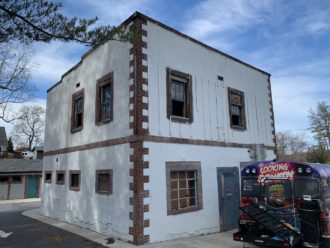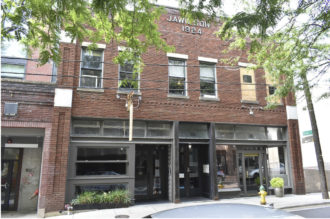Andrea Clark stands next to the J.A. Wilson Building in downtown Asheville and motions across Eagle Street to a city parking deck and some small retail spaces.
“There were barbershops, mortuaries, doctors, all the like,” the photographer says, recalling a time when Eagle Street was home to the city’s thriving African American business district. “Everything you would need, all the merchants, all right here. They tore it down, and they put this up.”
The two-story brick-faced Wilson building, constructed in 1924, is one of the few places left from Eagle Street’s golden age. Clark and other local preservationists want to make sure it and other significant African American historic sites around town are preserved for future generations.
A recent report done for the city’s Planning and Urban Design Department recommends the Wilson building and two other sites — the former Rabbit’s Motel on McDowell Street and the Walton Street Pool — be placed on the National Register Study List, a first step to being placed on the National Register of Historic Places.
The Asheville African American Heritage Resource Survey also identified about 75 buildings to be added to a list of Asheville historic architectural sites cataloged by the city.
“We’re lacking in survey work in our historically black neighborhoods,” says Alex Cole, the city’s historic preservation manager. “So, we decided to focus on documenting those resources so that we could help tell the stories of everyone in our community, in particular the stories of Black voices that have not been heard.”
To commemorate Black History Month, Xpress asked Clark and other longtime Asheville residents to share their memories of the three sites.
Rabbit’s Motel and Cafe, 109 McDowell St.

Opened in 1948 by Fred “Rabbit” Simpson, Rabbit’s was considered one of the top Black-owned motels for African American travelers in the segregation-era South. Among those known to have stayed there are future Baseball Hall of Famer Willie Stargell, who played for the Asheville Tourists in 1961, and pioneering Black NASCAR driver Wendell Scott.
Musicians touring the South on the Chitlin Circuit also were regular guests at the motel, which sat in the heart of the then-vibrant Southside neighborhood, home to more than half of Asheville’s African American population.
“It was listed in the Green Book: ‘If you’re Black and you’re coming through Asheville and you need a place to stay, eat and whatever, here’s the spot,’ ” says Roy Harris, a longtime Asheville resident and storyteller. The Negro Motorist Green-Book was an annual guide that provided a list of establishments throughout the country that served Black patrons.
“It had six motel rooms in the back, behind the restaurant,” remembers Robert Hardy, president of the Southside Community Association. “It had a sign with blinking neon lights, shaped like a rabbit. Looked like the rabbit was running across the yard. And it had a sign that said, ‘Colored Only.’ [Simpson] said ‘Well, if y’all want to be like that and don’t want us, we don’t want you.'”
The motel eventually became year-round housing and then closed, though no one seems to know the exact date. The rooms were converted into a music rehearsal and art studio called SoundSpace@Rabbit’s in 2020.
Still vacant is the two-story restaurant that faces McDowell Street in front of the former motor court.
“You could go to the restaurant there and get some of the best soul food in town,” recalls Renée White, president of the East End/Valley Street Neighborhood Association. “Black people were able to meet, eat, dance to the jukebox, laugh and socialize.”
Harris arrived in Asheville in 1983 and was directed by others to check out the no-frills spot whose sign promised “Real Home-Cooked Meals.”
“I don’t think anybody was staying upstairs, but they had a little kitchen downstairs, and, if I remember right, you couldn’t get more than maybe 10, 15 people at a time in there,” he says.
Priscilla Robinson has fond memories of picking up to-go orders. “They had chitlins, they had fried chicken, collard greens. It was homemade potato salad, hot dogs, hamburgers,” says Robinson, who documents changes in the Southside neighborhood through her Urban Renewal Impact website.
Things started going downhill when white people discovered the spot, Clark says. “They started to come, and suddenly here comes the city food inspection people. They kinda had to upgrade and so forth.”
The restaurant closed after that, though again the exact date is unclear. The last reference to the restaurant being open in the Asheville Citizen Times was in 2004.
“It’s important to Asheville’s Black community because it represented successful Black enterprise,” White explains. “A thriving business owned by Black people that provided motel space and good food.”
And, she adds: “I loved the fried chicken.”
Walton Street Pool and Park, 570 Walton St.

Situated at the southern end of the Southside neighborhood, the city-owned Walton Street Park opened to the public in June 1939 under the name Riverview Park. The pool was completed in the southwest corner of the park in fall 1947 and the pool house the following summer.
“The Walton Street Pool is where all of Black Asheville went and swam because we couldn’t use any other spot,” Robinson says. Many young people in the community became certified as lifeguards at the pool, she says.
Adds White: “I always felt that it was never maintained as well as the white pools because it was in a Black neighborhood.”
Hardy, 71, remembers a swim instructor named Big John Burleson. “Mr. Burleson taught a lot of us how to swim, and if he thought you could swim, Mr. Burleson would throw you in the water,” Hardy says with a laugh. “The only time he would go in was when you didn’t come up. This man could swim like a fish, and he taught the community how to swim.”
The park, with its gable-roofed picnic shelter, concession stand and playground, became a community hub for generations of African Americans. “We’d have our yearly carnival and class reunions, birthday parties and everything at that park,” Hardy recalls. “It was a neighborhood fixture.”
At one time, the park contained a clay tennis court, pavilion and more at the top of a hill, Hardy says. But the hill was removed as part of urban renewal efforts that saw the construction of public housing in the 1970s.
In 2021, Asheville City Council voted to close the pool due to a leaking foundation, mechanical failures and other infrastructure problems. The city is building a new outdoor pool with modern amenities at the nearby Grant Southside Center.
While the pool is history, the playground, picnic shelter, basketball court and more remain.
“There’s still families barbecuing, people hanging out,” Clark says. She bemoans the fact the park has seen violence but says young people need a place to hang out.
“We need to save the kids, give them recreation, a place to play,” she says. “They don’t get it in schools.”
Gazing out at the tree-lined park, she adds, “And it’s a really lovely spot.”
J.A. Wilson Building, 13 Eagle St.

Businessman J. Alfred Wilson moved his Wilson’s Barber Shop to the newly completed J.A. Wilson Building in 1925. Like Rabbit’s Motel, the shop was listed in the Green Book several times.
Over its long history, the building at the intersection of Eagle Street and Wilson Alley has provided space for doctors, dentists, real estate agents, lawyers and other Black-owned businesses. Its ground floor has been home to Limones, a modern Californian and Mexican restaurant, since 2004.
Clark doesn’t have many first-hand memories of the building. But it still is special to her, as evidenced by the words she reads aloud from a plaque on the outside wall: “This commercial building was built in 1924 for African-American businessman J. Alfred Wilson by the distinguished African-American brickmason James Vester Miller.”
Miller, who died in 1940, was Clark’s grandfather.
In 2021, she launched the James Vester Miller Historic Walking Trail to keep his name alive in Asheville. In addition to the Wilson building, Miller had a hand in building St. Matthias Episcopal Church, the YMI building, Mount Zion Missionary Baptist Church and other historic structures.
She sees such efforts as vital.
“It’s our history, and it needs to be preserved so that our children and our grandchildren and our great-great-great-grandchildren will know who did what in their community and where they came from,” Clark says. “You want to know where you came from so that you can know where you’re going.”




Kudos, per usual, to Andrea Clark and all her good work over the years …much appreciated!